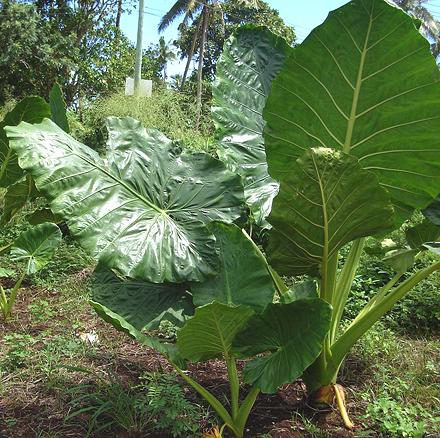Giant Taro
 [Giant Taro, Giant Alocasia (English); Badjang (Philippines); 'Ape (Hawaii
(not unique)); Vi'a or Bi'a (Taiwan Austronesian); Biga, Bira (Philippines);
Birah (Malay); Cunjevoi, Hakkin, Bargadga, Nargan, Bundal (Australia);
Alocasia macrorrhizos]
[Giant Taro, Giant Alocasia (English); Badjang (Philippines); 'Ape (Hawaii
(not unique)); Vi'a or Bi'a (Taiwan Austronesian); Biga, Bira (Philippines);
Birah (Malay); Cunjevoi, Hakkin, Bargadga, Nargan, Bundal (Australia);
Alocasia macrorrhizos]
A. macrorrhizos is not actually a Taro, but closely related
(Alocasia means "Like Taro). This plant is native to the rainforests
of Island Southeast Asia, and as far south as Queensland, Australia. It was
originally cultivated in the Philippines, and spread from there through the
Pacific Islands. Some islanders considered it "famine food", and much
preferred Taro. The leaves can get up to 6 feet long and over 3 feet wide.
A video from the Philippines shows a man uprooting a wild plant and
discarding the whole thing. The root was very short. He then started digging
out small Cormels from around where the root had been to actually cook and
eat. He did complain about them being so small (about 5 x 1-1/4 inches).
The leaf stems (petioles) of this plant are apparently used in some regions,
just sliced up, boiled, and included in curries. Usability of leaf stems may
depend on particular cultivars.
Nothing I have seen in photos, videos, or descriptions suggests the
"Big Taro" corms common in the
Philippine and Southeast Asian markets here in Los Angeles come from this
plant.
Photo by Tau'olunga distributed under license Creative Commons
Attribution-ShareAlike v2.5 Generic.
More on Arums.
 In the Philippines, a sweet called Binagol is traditionally made from the
Giant Taro, though most recipes I see for it call for regular Taro. This
confection is made with condensed milk, sugar, coconut milk, and egg yolks.
It is placed in a half coconut shell, wrapped in banana leaves, and steamed
for 30 minutes or more.
Photo by Judgefloro contributed to the Public Domain.
In the Philippines, a sweet called Binagol is traditionally made from the
Giant Taro, though most recipes I see for it call for regular Taro. This
confection is made with condensed milk, sugar, coconut milk, and egg yolks.
It is placed in a half coconut shell, wrapped in banana leaves, and steamed
for 30 minutes or more.
Photo by Judgefloro contributed to the Public Domain.
am_taroagz 210118 www.clovegarden.com
© Andrew Grygus - agryg@clovegarden.com - Photos on
this page not otherwise credited are ©
cg1.- Linking to and non-commercial use
of this page permitted.
 In the Philippines, a sweet called Binagol is traditionally made from the
Giant Taro, though most recipes I see for it call for regular Taro. This
confection is made with condensed milk, sugar, coconut milk, and egg yolks.
It is placed in a half coconut shell, wrapped in banana leaves, and steamed
for 30 minutes or more.
Photo by Judgefloro contributed to the Public Domain.
In the Philippines, a sweet called Binagol is traditionally made from the
Giant Taro, though most recipes I see for it call for regular Taro. This
confection is made with condensed milk, sugar, coconut milk, and egg yolks.
It is placed in a half coconut shell, wrapped in banana leaves, and steamed
for 30 minutes or more.
Photo by Judgefloro contributed to the Public Domain.
 [Giant Taro, Giant Alocasia (English); Badjang (Philippines); 'Ape (Hawaii
(not unique)); Vi'a or Bi'a (Taiwan Austronesian); Biga, Bira (Philippines);
Birah (Malay); Cunjevoi, Hakkin, Bargadga, Nargan, Bundal (Australia);
Alocasia macrorrhizos]
[Giant Taro, Giant Alocasia (English); Badjang (Philippines); 'Ape (Hawaii
(not unique)); Vi'a or Bi'a (Taiwan Austronesian); Biga, Bira (Philippines);
Birah (Malay); Cunjevoi, Hakkin, Bargadga, Nargan, Bundal (Australia);
Alocasia macrorrhizos]